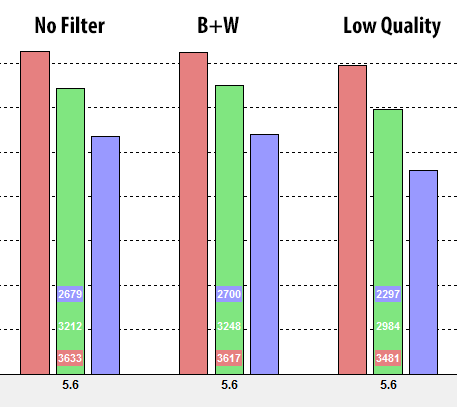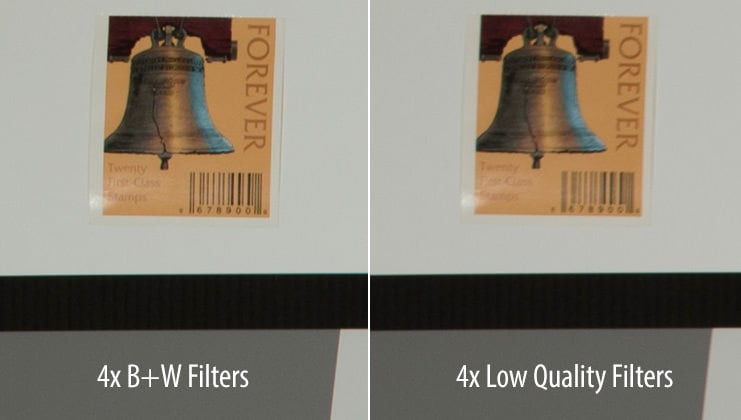ليست كل مرشحات العدسات متشابهة
Not All Lens Filters Are The Same
يمكن لموضوع استخدام أو عدم استخدام العدسات الواقية أن يثير نقاشات ساخنة بين المصورين، حيث يدافع الجانبان في كثير من الأحيان بشراسة عن خياراتهما. لن أناقش ما إذا كان من الصواب أو الخطأ استخدام المرشحات الواقية - فهذا بالتأكيد خيار شخصي. لقد كنت أستخدمها منذ عدة سنوات لحماية عدساتي المتطورة وتسهيل تنظيف العدسات ذات العناصر الأمامية الغائرة (مثل عدسة Nikon مقاس 50 مم f/1.4G / f/1.8G). بعد أن مررت بتجربة سيئة في شراء فلتر منخفض الجودة يحمل علامة تجارية بدون اسم عندما بدأت التصوير الفوتوغرافي للتو (تم بيعه لي باعتباره "ضروريًا" في متجر صور محلي)، تعلمت ما يمكن أن يفعله هذا الفلتر بصورتي الصور بالطريقة الصعبة. منذ ذلك الحين، قمت فقط بشراء مرشحات B+W متعددة الطبقات والتي تستخدم زجاج شوت عالي الجودة. لقد كنت سعيدًا جدًا بهذه المرشحات وأطلب من القراء إما استخدام أفضل ما يمكنهم العثور عليه، أو عدم استخدام المرشحات على الإطلاق.
قبل بضعة أسابيع، تلقيت مجموعة من المرشحات من شركة تصنيع مرشحات جديدة في أوروبا. أرادت الشركة مني أن أختبر مرشحاتها وأرى رأيي فيها. سألتهم عما إذا كانوا سيشعرون بالارتياح تجاه مقارنة مرشحاتهم بالأبيض والأسود وأخبروني أنهم لا يمانعون في ذلك. بينما كنت أختبر عدسة في مختبر Imatest الخاص بي منذ بضعة أيام، قمت أولاً بتصوير مخطط اختبار بدون مرشحات عند f/5.6، ثم قمت بتجميع 4 مرشحات مقاس 77 مم B+W XS-Pro MRC والتقطت لقطة أخرى، ثم أخيرًا تم تركيب 4 مرشحات من الشركة المصنعة الجديدة والتقطت اللقطة الأخيرة. فيما يلي الأرقام التي تم إنتاجها بواسطة Imatest:
أحمر: إطار مركزي، أخضر: إطار متوسط، أزرق: إطار زاوية
The subject of using or not using protective lenses can invoke heated debates among photographers, with both sides often fiercely defending their choices. I am not going to debate whether it is right or wrong to use protective filters – that’s certainly a personal choice. I have been using them for a number of years now to protect my higher-end lenses and make it easier to clean lenses with recessed front elements (such as on Nikon 50mm f/1.4G / f/1.8G). Having had bad experience with purchasing a low-quality no-name brand filter when I just started photography (it was sold to me as a “must-have” at a local photo store), I learned what such a filter can do to my photos the hard way. Since then, I have only been purchasing multi-coated B+W filters that use high-quality Schott glass. I have been very happy with these filters and have been telling our readers to either use the best they can find, or not use filters at all.
A couple of weeks ago, I received a bunch of filters from a new filter manufacturer in Europe. The company wanted me to test their filters and see what I think of them. I asked them if they would be comfortable with me comparing their filters to B+W and they told me that they did not mind. As I was testing a lens in my Imatest lab a couple of days ago, I first shot a test chart without filters at f/5.6, then stacked 4 of my 77mm B+W XS-Pro MRC filters and took another shot, then finally mounted 4 filters from the new manufacturer and took the last shot. Here are the numbers that were produced by Imatest:
 Red: Center Frame, Green: Mid-Frame, Blue: Corner Frame
Red: Center Frame, Green: Mid-Frame, Blue: Corner Frame
Not All Lens Filters Are The Same
يمكن لموضوع استخدام أو عدم استخدام العدسات الواقية أن يثير نقاشات ساخنة بين المصورين، حيث يدافع الجانبان في كثير من الأحيان بشراسة عن خياراتهما. لن أناقش ما إذا كان من الصواب أو الخطأ استخدام المرشحات الواقية - فهذا بالتأكيد خيار شخصي. لقد كنت أستخدمها منذ عدة سنوات لحماية عدساتي المتطورة وتسهيل تنظيف العدسات ذات العناصر الأمامية الغائرة (مثل عدسة Nikon مقاس 50 مم f/1.4G / f/1.8G). بعد أن مررت بتجربة سيئة في شراء فلتر منخفض الجودة يحمل علامة تجارية بدون اسم عندما بدأت التصوير الفوتوغرافي للتو (تم بيعه لي باعتباره "ضروريًا" في متجر صور محلي)، تعلمت ما يمكن أن يفعله هذا الفلتر بصورتي الصور بالطريقة الصعبة. منذ ذلك الحين، قمت فقط بشراء مرشحات B+W متعددة الطبقات والتي تستخدم زجاج شوت عالي الجودة. لقد كنت سعيدًا جدًا بهذه المرشحات وأطلب من القراء إما استخدام أفضل ما يمكنهم العثور عليه، أو عدم استخدام المرشحات على الإطلاق.
قبل بضعة أسابيع، تلقيت مجموعة من المرشحات من شركة تصنيع مرشحات جديدة في أوروبا. أرادت الشركة مني أن أختبر مرشحاتها وأرى رأيي فيها. سألتهم عما إذا كانوا سيشعرون بالارتياح تجاه مقارنة مرشحاتهم بالأبيض والأسود وأخبروني أنهم لا يمانعون في ذلك. بينما كنت أختبر عدسة في مختبر Imatest الخاص بي منذ بضعة أيام، قمت أولاً بتصوير مخطط اختبار بدون مرشحات عند f/5.6، ثم قمت بتجميع 4 مرشحات مقاس 77 مم B+W XS-Pro MRC والتقطت لقطة أخرى، ثم أخيرًا تم تركيب 4 مرشحات من الشركة المصنعة الجديدة والتقطت اللقطة الأخيرة. فيما يلي الأرقام التي تم إنتاجها بواسطة Imatest:
أحمر: إطار مركزي، أخضر: إطار متوسط، أزرق: إطار زاوية
The subject of using or not using protective lenses can invoke heated debates among photographers, with both sides often fiercely defending their choices. I am not going to debate whether it is right or wrong to use protective filters – that’s certainly a personal choice. I have been using them for a number of years now to protect my higher-end lenses and make it easier to clean lenses with recessed front elements (such as on Nikon 50mm f/1.4G / f/1.8G). Having had bad experience with purchasing a low-quality no-name brand filter when I just started photography (it was sold to me as a “must-have” at a local photo store), I learned what such a filter can do to my photos the hard way. Since then, I have only been purchasing multi-coated B+W filters that use high-quality Schott glass. I have been very happy with these filters and have been telling our readers to either use the best they can find, or not use filters at all.
A couple of weeks ago, I received a bunch of filters from a new filter manufacturer in Europe. The company wanted me to test their filters and see what I think of them. I asked them if they would be comfortable with me comparing their filters to B+W and they told me that they did not mind. As I was testing a lens in my Imatest lab a couple of days ago, I first shot a test chart without filters at f/5.6, then stacked 4 of my 77mm B+W XS-Pro MRC filters and took another shot, then finally mounted 4 filters from the new manufacturer and took the last shot. Here are the numbers that were produced by Imatest:
 Red: Center Frame, Green: Mid-Frame, Blue: Corner Frame
Red: Center Frame, Green: Mid-Frame, Blue: Corner Frame

 NIKON D800E @ 55mm, ISO 100, 1/8, f/5.6
NIKON D800E @ 55mm, ISO 100, 1/8, f/5.6
تعليق